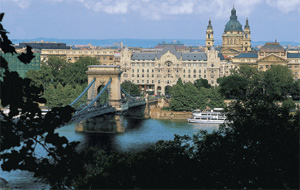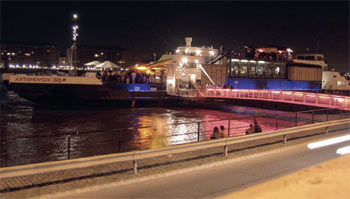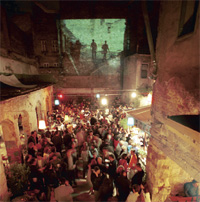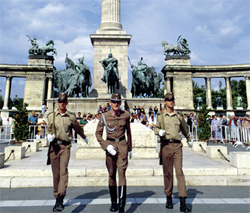
Every issue we give you the lowdown on a city that you should travel to with haste. These essential guides are written by people who know said city inside out because they live there, rather than London-based numpties like us…
Words by Adrian Courage
I’m going to be straight with you, Budapest can be quite bewildering for the first-timer. Bewildering in a good way, like being thrown in at the deep end in your pyjamas and told to rescue a rubber brick. If a dose of culture shock gets your adrenaline pumping, this is the place for you. Even for someone who has lived in the country for years, it never fails to throw up new surprises. That’s not to say Budapest doesn’t have instant appeal, of course. It has architectural eye candy by the bucketload and there are not many major cities in the world with a sheer cliff face bang in the centre of town. Some of Budapest is just as Mother Nature made it – like the wooded Buda Hills to the east – while Pest combines rundown former glory with modern cosmopolitan energy. And what they say about dogs and their owners also applies to a city and its residents – Budapesters are suitably incomprehensible, impatient and intriguing.

Drinking
Hungarians love to drink, but rarely just for the hell of it. It’s easy to see why when bars and clubs open until 4 or 5am, even on a weekday, so there’s rarely any rush to have a good time. To make things more interesting, one of the quirks of Budapest is that the action is spread all around the city, so the intrepid traveller can always find somewhere to party nearby, although the best venues may not be immediately obvious from street level. An essential starting point is always one of the kerts or romkocsmák – Hungarian for “gardens” and “ruin pubs” respectively. These are crumbling outdoor or indoor spaces that have been cobbled together from discarded furniture. It may be in all the guidebooks and full of foreigners and expats, but it would be a grave mistake not to recommend Szimpla kert (District VII, Kazinczy utca 14) as the one place no visitor to BP should miss. Those that simply have to have everything in the same street should head to Nagymező utca and the surrounding area with cellar clubs like Soho London (cheesy but lively), Szilvuplé (house party vibe), Mono (experimental electronic, monoklub.hu) and the bordello-like Piaf (recommended only after all the others at 5am or later). For live music, it is worth checking out A38 (a38.hu), an old Ukrainian cruiser moored on the Buda side of Petőfi Bridge.

Shopping
Shopping in Budapest, like everything else, is an eclectic experience. Giant shopping centres are springing up all over town, but the real fun is to be had in the small designer boutiques and, in particular, the secondhand shops. The pick of the former are Eklektick (District V, Irinyi utca 20) and Naray Tamás (District V, Károlyi Mihály utca 12). As for the latter, for some reason, a lot of good used stuff gets sent over from the UK to Hungary and sold for peanuts if you have the time and patience to scour through it all. One-of-akind originals from local designers can be found at Látomás (District V, Dohány, utca 20). Second-hand shops are all over Budapest, but the biggest and best is Sik-Sik (District VII, Rákóczy út 30). There is even an “American hippie” section upstairs and a huge selection of cast off biker gear and leather jackets, definitely the place to go if the airline loses your luggage or you are facing a fancy dress emergency.
Sleeping
There is no shortage of places to stay in Budapest, but if you want to be central, stick to districts I, V, VI, VII and VIII (the two middle letters of the postcode indicate the district, i.e. 1056 is district V). If you can twist your boss’s arm , or even better have a sugar daddy, go for the Four Seasons Gresham Hotel – voted the world’s best by magazines much posher than this one – and if you can’t stay, just drop in for a coffee. The interior really is breathtaking. At the other end of the price spectrum, the Domino Hostel (District V, Váci utca 77) is the newest and most polished hostel and, most importantly, it’s bang in the centre of town.

Food
To see what Hungarians really eat, head for one of the city’s many covered markets, but try to steer clear of the touristy Nagycsarnok (District 9, Vámház körút 1-3). The most central alternative is the Hold utca market, but there are others behind the Mammut shopping centre (District II, Lövőház utca 12), and on Lehet tér (District XIII, a couple of stops on the blue metro line). While you’re there, make sure you try a lángos (fried dough) and a rétes (Hungary’s less fluffy answer to the strudel), and don’t forget to buy a stick of szalámi to take home.

Eating Out
You can eat just about anything in Budapest these days, but the two best Hungarian restaurants at the moment are Klassz (District VI, Andrássy út 41) and Csalogány 26 (District I, Csalogány utca 26), both of which place emphasis on fresh ingredients cooked the right way. Klassz – like many places in Hungary – seems like it will never be finished, but nevertheless it offers some of the best value fine dining in town. Be warned that it is very popular and doesn’t accept table bookings, so show up early to get a table. C26 is slightly higher up the price scale, but keeps its feet firmly on the ground and even has a live TV feed into the kitchen. For a truly Hungarian experience, visit Kispipa (District VII, Akácfa utca 38), a traditional restaurant with illogical prices like Ft 327 and Ft 841, or the Kádár Étkezde (District VII Klauzal tér 9), which is a crowded, basic and extremely charming diner open only on lunchtimes from Tuesday to Saturday.

Getting Around
The views from any of the bridges along the Danube are spectacular and a stroll up to the Castle District is pure tourist heaven. Budapest is a great city to stroll around in, but to really get into the spirit of the place, and see more of it, explore by public transport, as many expats say it’s the best thing about the city. It is actually pretty difficult to get lost if you use the Danube, metro lines and shiny new 4 and 6 tram line along the Grand Boulevard (Nagykörút) as a point of reference.
Culture
Budapest is a city bustling with energy and history. There’s always something going on from the majestic opera to gypsy jazz clubs and open-air festivals. August’s week-long Sziget festival on Shipyard Island is the year’s highlight, attracting thousands of party junkies from all over Europe. For an eclectic mix of music and people any time of the year, Gödör is a good bet. Originally built as a car park for the aborted national theatre project, the building was eventually put up on the banks of the Danube to the south, while the square was filled with an urban park perfect for people watching. To immerse yourself in the local culture, traditional dance houses (tánzházak) are a hoot at clubs like Fonó (District 11, Sztregova utca 3).

Essential Vocab
Hello and good bye: Szia (see-ya) or helló (hell-oh).
Thank you: Köszönöm (kuh-suhnuhm) or köszi (kuh-si) for short.
Sorry: Bocsánatot kérek (botchah- nat-tot keeh-rek) or bocs (botch) for short.
Three portions of goulash soup and a bottle of dry red wine: Három adag gulyásleves és egy üveg száraz vörös bor.
Megszentségteleníthetetlenségeskedéseitekért: the longest word in Hungarian, makes about as much sense as supercalifragilisticexpialidocious.
Rough Spend
£1: 356 Forint (Ft)
Beer: Ft 350 – Ft 600
Gyros/kebab: Ft 450
Restaurant main course: Ft 800 – Ft 2,500
Bus ride: Ft 230
Hour in Internet café (wireless is everywhere though): Ft 100
For events, venues, maps and contact details visit caboodle.hu; for updated restaurant reviews visit chew.hu; and for daily amusement Budapeststyle visit pestiside.hu.

